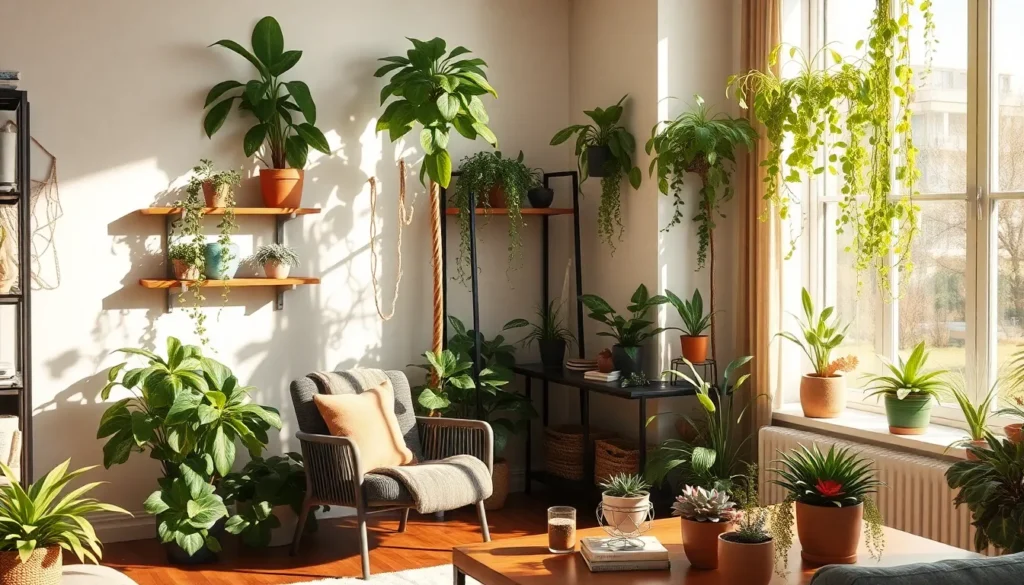We’ve all walked into a living room and immediately felt drawn to those lush green corners that seem to breathe life into the entire space. There’s something magical about combining the comfort of our favorite room with the natural beauty of plants – it transforms an ordinary living area into a vibrant sanctuary that welcomes both family and guests.
The best part? You don’t need a green thumb or expensive renovations to create stunning plant-filled living spaces. Whether you’re working with a cozy apartment or a spacious family room we’ll show you how strategic plant placement can enhance your décor while improving air quality and creating that coveted biophilic design everyone’s talking about.
From towering statement plants that anchor empty corners to cascading vines that soften harsh architectural lines we’re about to explore creative ideas that’ll help you curate the perfect plant-lover’s paradise right in your living room.
Choose the Right Plants for Your Living Room Environment
Selecting the perfect plants for your living room transforms your space into a thriving indoor oasis. We’ll guide you through matching plant characteristics to your exact environment and lifestyle needs.
Consider Light Conditions and Window Placement
Bright light areas near south-facing windows accommodate sun-loving plants like fiddle leaf figs, snake plants, and rubber trees. These statement plants thrive in direct sunlight and create dramatic focal points in your living room design.
Medium light spaces positioned 3-6 feet from windows work well for pothos, ZZ plants, and peace lilies. Place these versatile options on coffee tables, side tables, or plant stands to add greenery without overwhelming your furniture arrangement.
Low light corners away from windows still support plant life with options like Chinese evergreens, cast iron plants, and philodendrons. Position these shade-tolerant varieties in dimmer areas where other plants would struggle to survive.
Artificial lighting extends your plant placement options throughout the room using grow lights or LED strips. Install these supplemental light sources above bookshelves, entertainment centers, or darker corners to expand your living room plant possibilities.
Select Low-Maintenance Varieties for Busy Lifestyles
Drought-tolerant succulents like aloe vera, jade plants, and echeveria require watering only once every 2-3 weeks. Group these water-wise plants on windowsills, coffee tables, or floating shelves for easy care and modern appeal.
Self-sufficient air plants need minimal attention with weekly misting and monthly soaking sessions. Hang these unique specimens in glass terrariums, wall-mounted holders, or decorative bowls to create conversation pieces.
Resilient foliage plants such as spider plants, rubber trees, and monstera deliciosa forgive occasional neglect while maintaining their beauty. Choose these forgiving varieties if you travel frequently or have unpredictable schedules.
Slow-growing options like ZZ plants and snake plants maintain their shape for months without pruning or repotting. Invest in these long-term answers to minimize ongoing maintenance while maximizing visual impact.
Match Plant Sizes to Your Space Constraints
Floor plants measuring 3-6 feet tall serve as natural room dividers and architectural elements in spacious living rooms. Position large fiddle leaf figs, bird of paradise, or tall snake plants in corners or beside furniture to create vertical interest.
Tabletop plants ranging 6-18 inches complement existing décor without overwhelming surfaces like coffee tables, end tables, and console tables. Select compact varieties like small pothos, prayer plants, or mini monstera for proportional balance.
Hanging plants maximize vertical space while keeping floor areas clear for foot traffic and furniture placement. Suspend trailing varieties like string of hearts, ivy, or spider plants from ceiling hooks or wall-mounted brackets.
Miniature plants under 6 inches fit perfectly on narrow shelves, windowsills, and crowded surfaces where larger plants won’t work. Arrange small succulents, air plants, or herb gardens in clusters for greater visual impact in tight spaces.
Create Stunning Floor Plant Arrangements
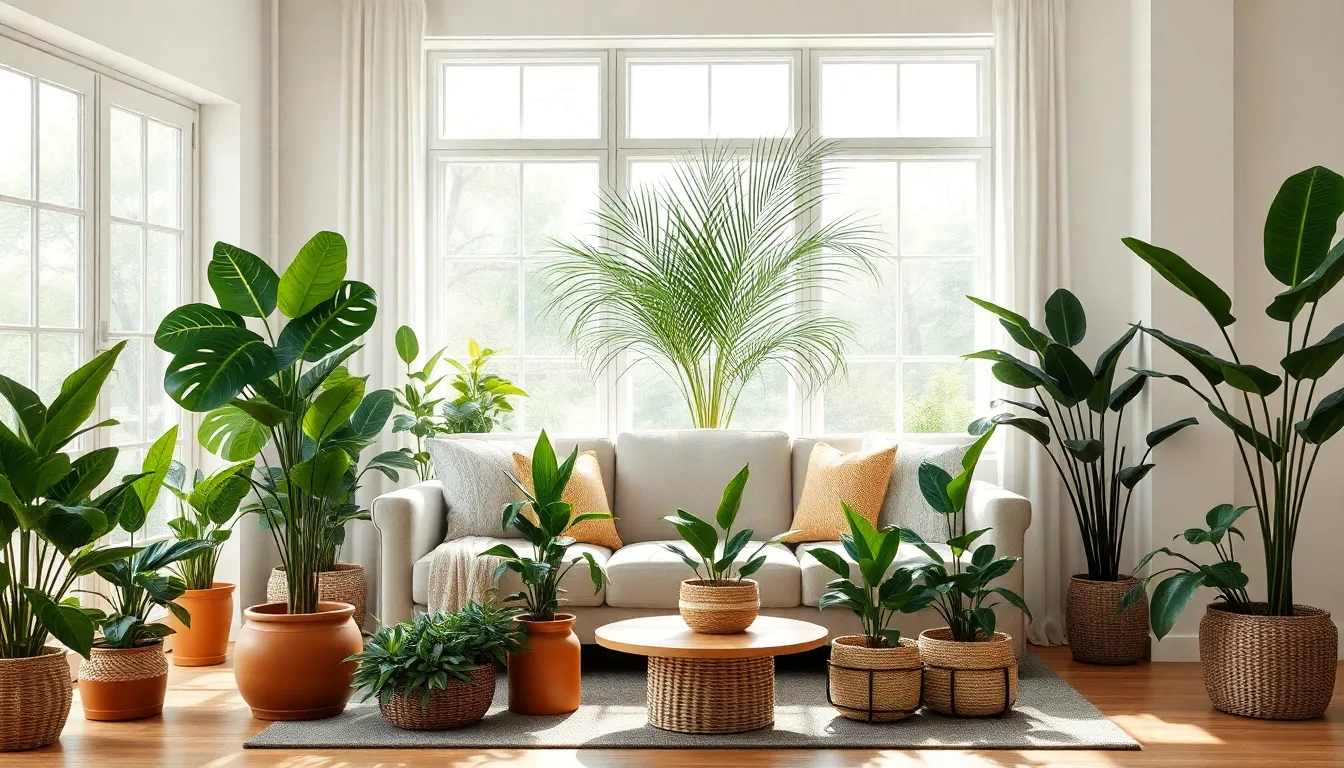
Floor plants transform our living rooms into green sanctuaries that feel both sophisticated and welcoming. Strategic placement of these botanical beauties creates focal points while maximizing our space’s natural appeal.
Position Large Plants as Natural Room Dividers
Large plants with broad leaves work as organic room dividers that softly define seating areas without blocking light or sightlines. Areca Palms (Dypsis lutescens) excel at this task while creating a tropical atmosphere and filtering the air naturally. We can place them strategically to segment large living rooms or open concept spaces, offering both privacy and greenery in one elegant solution. Umbrella Plants (Shefflera gold capella) also function beautifully as dividers due to their full foliage and impressive height potential.
Use Tall Plants to Add Vertical Interest
Vertical height prevents our rooms from looking flat and draws the eye upward to create dimensional depth. Plants that grow tall but remain slim, such as Fiddle Leaf Figs or Umbrella Plants, work ideally for adding this crucial vertical element. Hanging varieties like String of Pearls (Senecio rowleyanus) contribute vertical layers without consuming floor space, making them especially useful in small rooms or tight corners. We can position these towering beauties in stylish containers such as terracotta pots, vintage crocks, or woven baskets to add texture and personality to our arrangements.
Group Plants of Different Heights for Visual Drama
Combining plants with varying heights and textures creates visually captivating displays that feel intentional and curated. We can position a tall Umbrella Plant next to a medium sized peace lily and a trailing pothos on a nearby shelf or plant stand for maximum impact. This layering technique mimics how plants grow in natural environments and makes our decor feel organic rather than forced. Mixing plants with different leaf shapes and sizes enhances the natural appeal while creating lush, ever-changing groupings that serve as living art installations.
Design Eye-Catching Plant Shelving Displays
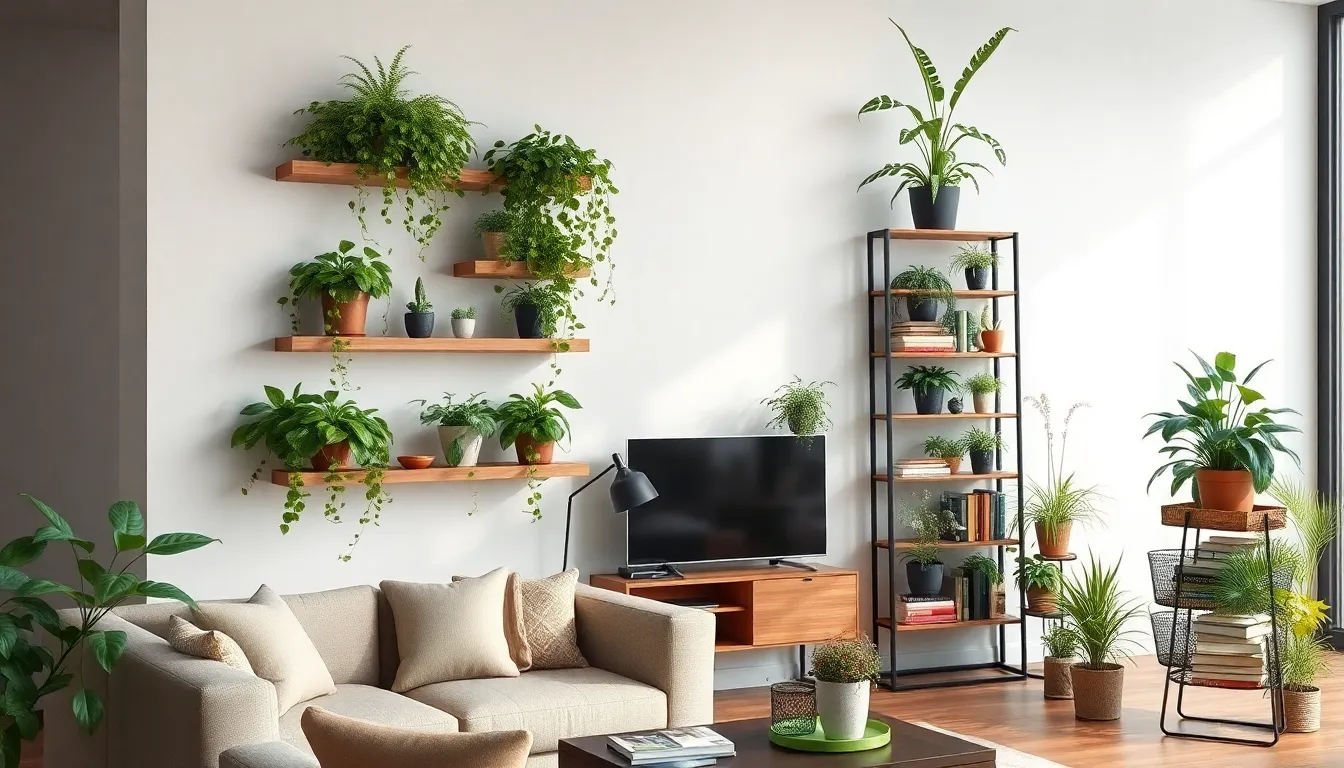
Moving beyond floor arrangements, we can transform our walls into living art galleries through strategic shelving displays. Smart shelving answers maximize our vertical space while creating stunning focal points that complement our existing floor plant arrangements.
Install Floating Shelves for Cascading Plants
Floating shelves mounted at varying heights create dramatic green waterfalls in our living rooms. We can install these sleek supports on any wall to hold trailing plants like philodendrons or string of pearls, whose vines cascade downward in elegant natural flows. Modern floating designs offer clean lines that complement contemporary décor while providing the perfect platform for plants whose leaves can drape gracefully below.
Strategic placement at different elevations adds visual depth without consuming precious floor space. We position these shelves to create layered displays where each plant’s cascading habit contributes to an overall green curtain effect. Plants like pothos and ivy thrive on floating shelves because their trailing nature softens sharp architectural lines and creates organic movement throughout our living spaces.
Repurpose Bookshelves as Plant Display Units
Bookshelves become versatile plant stands when we clear strategic spaces among our book collections. We integrate potted plants of varying heights and leaf shapes between books to create personality driven displays that combine literature with living greenery. Wooden bookshelves suit rustic interiors while metal units complement modern aesthetics, giving us flexibility to match our existing décor themes.
Mixed arrangements of books and plants add warmth and character to our living rooms. We select plants with different textures and sizes to create visual interest among our book spines, transforming ordinary storage into ever-changing display units. This approach maximizes our existing furniture while creating functional plant displays that serve dual purposes in our space planning.
Create Tiered Plant Stands for Maximum Impact
Tiered plant stands maximize our vertical growing space while organizing multiple plants into cohesive lush corners. We choose stands made from metal, wood, or rattan materials that complement our interior design style and support various plant weights safely. These multilevel displays enable us to showcase tall, bushy, and trailing plants together in organized arrangements that remain easily accessible for maintenance.
Layered plant presentations create dramatic green statements in corners or against walls where single plants might appear sparse. We arrange plants of different heights and textures on each tier to build visual depth and mimic natural forest environments. Strategic placement allows each plant adequate light exposure while creating stunning groupings that transform ordinary corners into vibrant plant sanctuaries.
Incorporate Hanging Plants for Elevated Style
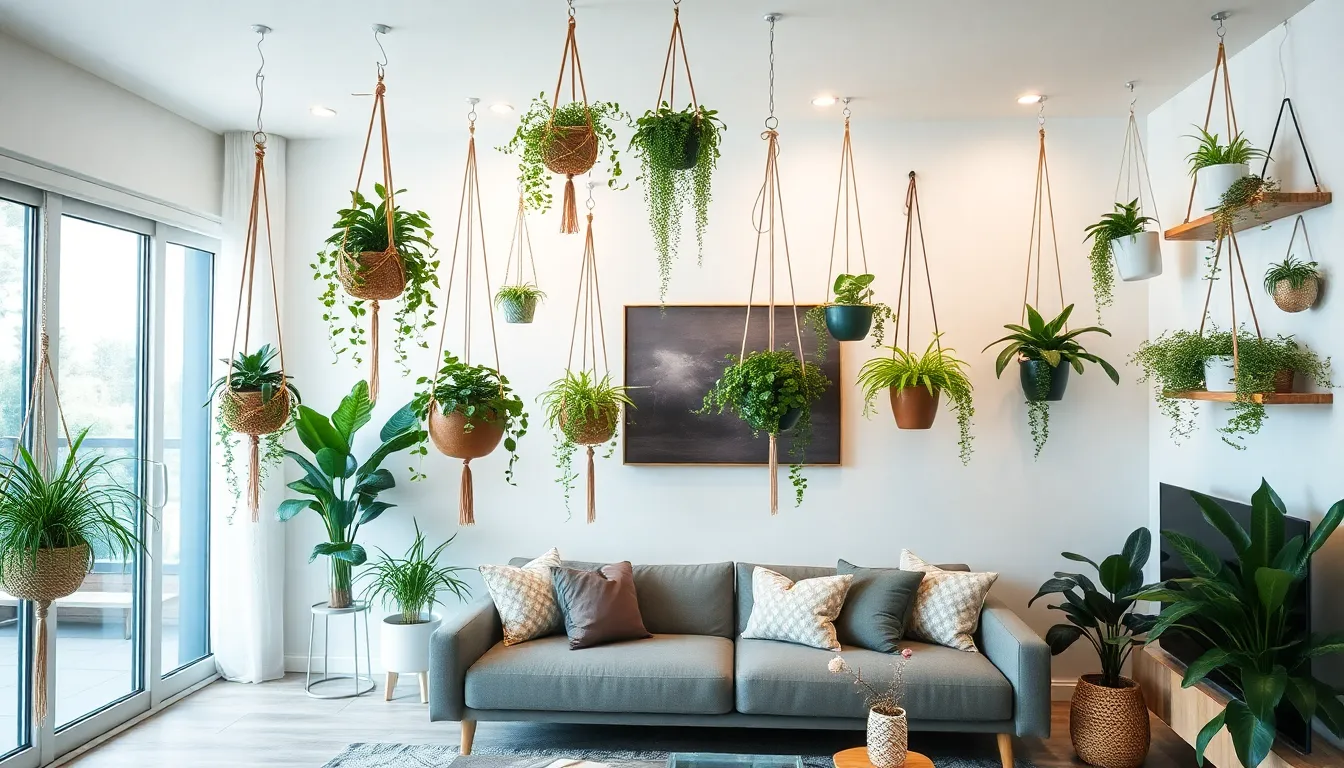
Hanging plants transform your living room by bringing greenery to eye level without consuming valuable floor or surface space. We can create stunning vertical gardens that add dimension and natural beauty to any room using strategic placement techniques.
Choose Trailing Plants for Dramatic Cascades
Trailing plants create breathtaking cascading effects that draw the eye both upward and downward throughout your space. English ivy offers classic elegance with its distinctive leaf patterns that flow gracefully from elevated positions. Heartleaf philodendrons provide lush, heart-shaped foliage that creates dense green curtains perfect for framing windows or doorways.
Spider plants deliver both beauty and functionality with their variegated leaves and cascading baby plantlets that add movement to your décor. Devil’s ivy thrives in various lighting conditions while producing long, trailing vines that can extend several feet from their containers. Boston ferns contribute feathery, delicate fronds that create soft, organic shapes perfect for adding texture to modern living spaces.
Install Ceiling Hooks and Macrame Hangers
Ceiling hooks designed for weight-bearing applications provide secure mounting points for your hanging garden displays. We recommend installing hooks into ceiling joists or using heavy-duty drywall anchors rated for at least 20 pounds to ensure safety. Macrame hangers add trendy, boho-chic texture while providing sturdy plant support that complements various interior design styles.
Positioning ceiling hooks at different heights creates visual interest and prevents your hanging plants from appearing uniform or flat. Strategic placement near windows maximizes natural light exposure while maintaining the floating garden effect that makes rooms feel larger and more ever-changing.
Use Wall-Mounted Planters to Save Floor Space
Wall-mounted planters offer practical answers for integrating greenery into smaller living rooms or spaces with limited surface area. Attaching terracotta pots directly to walls creates unexpected green features that serve as living artwork throughout your room. Small planters work exceptionally well for succulents and seasonal blooming plants that require minimal watering and maintenance.
Vertical wall gardens maximize your plant display potential while keeping floors completely clear for furniture and foot traffic. We can arrange multiple wall-mounted planters at varying heights to create geometric patterns or organic flowing designs that complement your existing décor style.
Style Plants with Decorative Containers
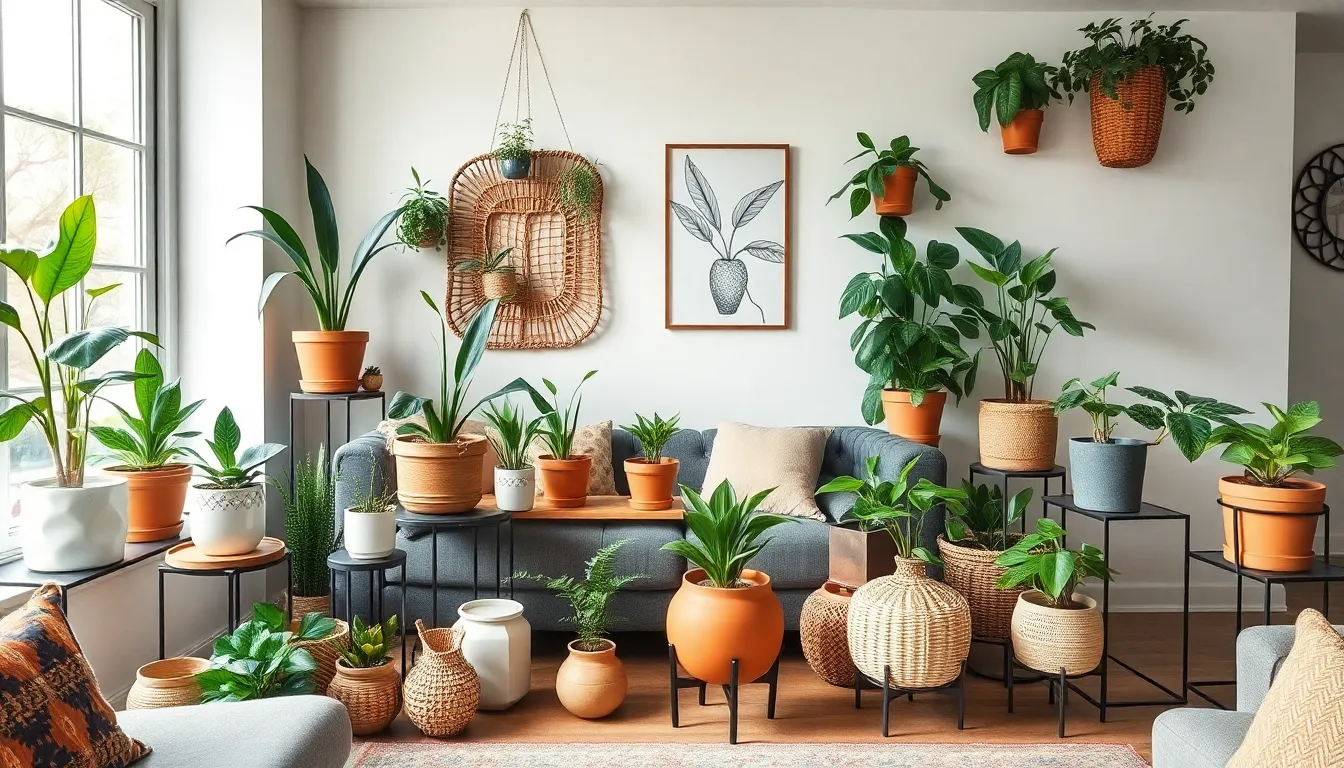
We believe the right container can transform any ordinary plant into a stunning focal point that elevates your entire living room design.
Select Pots That Complement Your Decor Theme
Choosing containers that harmonize with your existing interior style creates a cohesive and intentional look throughout your space. Modern minimalist rooms benefit from clean lines and neutral tones found in simple ceramic or concrete planters that won’t compete with your furniture. Rustic or farmhouse themes shine when paired with vintage terracotta pots, weathered wooden planters, or repurposed galvanized buckets that add authentic charm.
Bohemian spaces come alive with colorful ceramic vessels, woven baskets, and macrame plant holders that reflect the eclectic aesthetic. Industrial decor pairs beautifully with metal containers, concrete pots, and repurposed items like old toolboxes or galvanized steel planters. Matching your pot colors to existing room accents like throw pillows, artwork, or furniture creates visual harmony that ties the entire design together.
Mix and Match Different Textures and Materials
Combining various materials and textures creates ever-changing visual interest that prevents your plant display from looking flat or monotonous. Ceramic pots offer smooth, polished surfaces that contrast beautifully with rough terracotta or textured concrete planters. Glass containers provide transparency that allows you to showcase interesting root systems or decorative stones while adding lightness to heavier arrangements.
Woven baskets introduce natural warmth and soften the harder edges of ceramic or metal containers. Metal planters in copper, brass, or galvanized steel add industrial elements that create sophisticated contrast when grouped with organic materials. Wooden plant stands or holders bring earthy textures that ground the arrangement while providing natural warmth.
Foliage textures play an equally important role in creating visual depth. Broad leaf plants like Monstera deliciosa contrast beautifully with fine, delicate trailing vines such as String of Pearls or pothos varieties. This layered approach ensures your plant groupings remain visually captivating from every angle.
Use Plant Stands and Risers for Added Height
Creating different elevation levels throughout your living room adds dimensional interest that draws the eye upward and makes spaces feel larger. Floor level arrangements work perfectly for tall statement plants like Areca Palms or Umbrella Plants that naturally command attention without additional height. Mid level positioning using plant stands or risers elevates medium sized plants like peace lilies or snake plants to create perfect visual balance.
Hanging planters and wall mounted shelves maximize vertical space while showcasing trailing varieties like English ivy or heartleaf philodendrons. Tiered plant stands organize multiple plants into cohesive arrangements that create mini indoor gardens without consuming excessive floor space. Corner shelving units transform unused areas into lush plant displays that add life to previously empty spaces.
Repurposed items like vintage stools, wooden crates, or decorative pedestals serve as unique plant risers that add personality while providing functional height variation. This approach proves especially valuable in smaller living rooms where floor space remains limited but vertical opportunities abound.
Integrate Plants into Existing Furniture

Working with your current furniture pieces creates the most seamless way to add greenery without requiring major room changes. Small potted plants can transform ordinary surfaces into living displays when placed strategically on shelves, side tables, and built-in furniture nooks.
Transform Coffee Tables with Succulent Gardens
Coffee tables offer the perfect canvas for creating stunning succulent centerpieces that require minimal maintenance. Succulents thrive in indirect light conditions and need watering only occasionally, making them ideal companions for your central gathering space. We recommend arranging different shapes and sizes of succulents in shallow planters or terrariums to create unique botanical focal points.
Choose low-profile containers that won’t obstruct conversation views across your coffee table. Mixing various succulent varieties like echeveria, jade plants, and string of pearls creates textural interest while maintaining the clean, organized look that works well in living spaces. These drought-tolerant plants handle the occasional coffee spill and busy household activity with remarkable resilience.
Add Plant Ledges to Window Sills
Window sills provide natural stages for plants that appreciate consistent light exposure throughout the day. Installing plant ledges maximizes these prime real estate spots by creating dedicated spaces for medium-light loving plants like Areca Palms and Umbrella Plants. These species flourish in medium, indirect sunlight that filters through most living room windows.
Trailing plants like String of Pearls work beautifully on higher ledges, where their cascading tendrils can create dramatic greenery effects without interfering with window operations. We suggest measuring your window depth to ensure ledges accommodate various pot sizes while maintaining easy access for plant care. Natural light positioning helps brighten rooms with living color while supporting healthy plant growth.
Style Console Tables with Greenery Accents
Console tables become ever-changing plant displays when we pair greenery with decorative objects like woven baskets and vintage vessels. Air-purifying plants such as pothos and peace lilies bring life to these surfaces while requiring minimal daily attention. Stylish containers like vintage crocks or terracotta pots add charm while blending seamlessly with existing décor themes.
Layering plants of varying heights and textures creates curated looks that reflect your personal style preferences. We recommend grouping three to five plants with complementary foliage colors and leaf shapes for maximum visual impact. This approach transforms console tables into living art installations that enhance your room’s atmosphere while maintaining the functional aspects of these furniture pieces.
Create Dedicated Plant Corners and Nooks
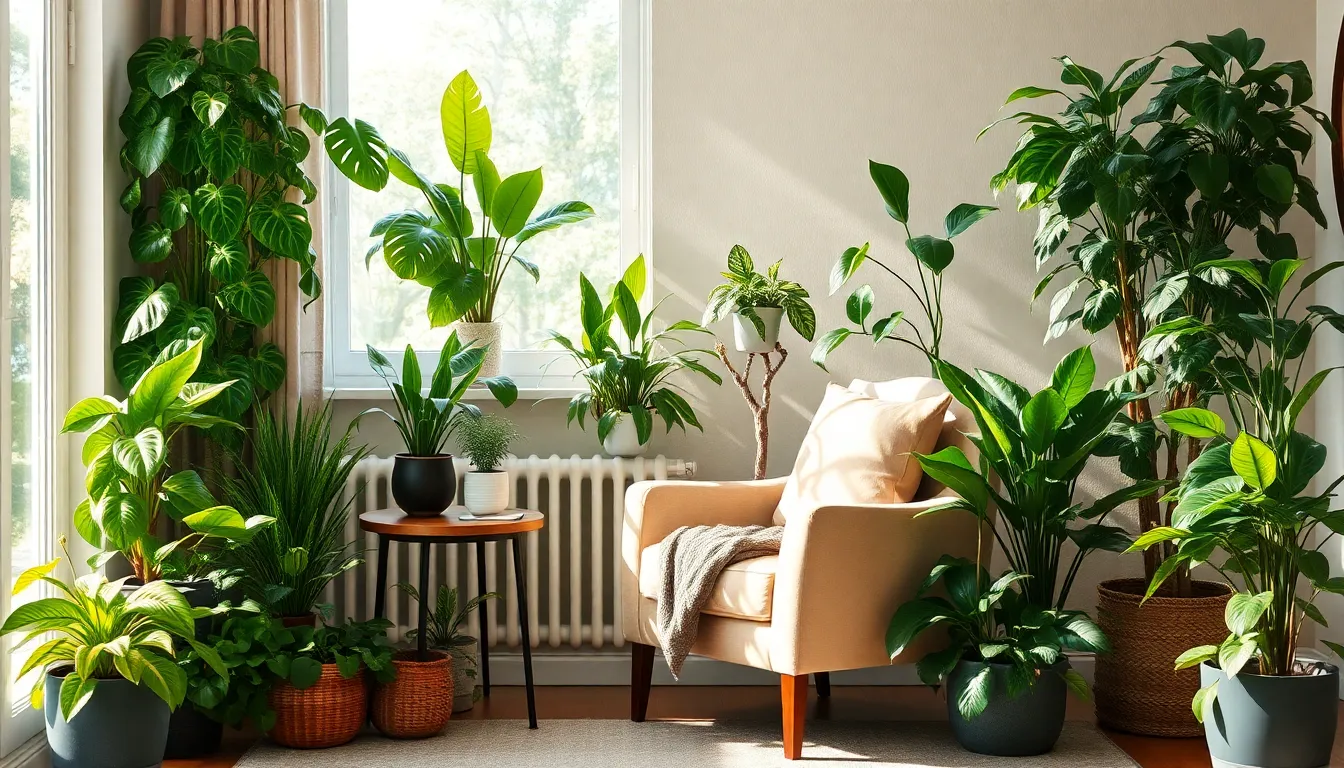
Transform underutilized spaces into stunning focal points by establishing dedicated areas solely for your green collection. We’ll explore how strategic plant placement can maximize both visual impact and spatial efficiency.
Design a Reading Nook Surrounded by Plants
Creating a plant-surrounded reading corner brings tranquility and improved air quality to your relaxation space. We recommend positioning easy-care varieties like Pothos or Snake Plants around a cozy chair, as these thrive in indirect light conditions typical of reading areas. Hanging plants at eye level provide greenery without consuming valuable floor space, while wall-mounted planters maintain the serene atmosphere you’re seeking.
Place cascading String of Pearls or trailing English ivy above your reading spot to create a natural canopy effect. We suggest incorporating multiple plant heights around your chair—tall floor plants like Dragon Trees behind the seating area, medium-sized Rubber Plants on nearby stands, and small tabletop varieties on side tables. This layered approach envelops you in nature while maintaining comfortable access to books and beverages.
Transform Empty Corners into Green Sanctuaries
Empty corners offer perfect opportunities for creating mini ecosystems that serve as natural focal points. We recommend starting with large floor plants like Umbrella Plants or Areca Palms, which bring immediate height and visual interest to these neglected spaces. Layering medium-sized plants such as Monstera or Fiddle Leaf Figs adds fullness and creates depth within your corner sanctuary.
Maximize vertical space by incorporating tiered plant stands or decorative shelving units that accommodate multiple plant sizes. We suggest mixing textures and leaf shapes—combine broad-leafed plants with spiky succulents or delicate ferns to create visual contrast. Decorative pots in complementary materials like ceramic, wicker, or metal enhance the aesthetic appeal while maintaining cohesion with your existing decor.
Use Room Dividers to Create Plant Zones
Room dividers transform open floor plans into distinct plant-focused areas while maintaining spatial flow. We recommend utilizing screens or shelving units as foundations for living partitions that incorporate both privacy and greenery. Plant shelves mounted on or around dividers create functional display spaces for various species, from cascading Pothos to upright palms.
Strategic placement of hanging planters on room dividers adds vertical interest without blocking natural light flow. We suggest combining different plant growth patterns—use trailing vines like Devil’s Ivy to soften hard edges while incorporating structured plants like Snake Plants for architectural contrast. This approach doubles your divider’s function as both a spatial organizer and an impressive plant display that enhances your room’s overall charm and biophilic design elements.
Combine Plants with Proper Lighting Solutions
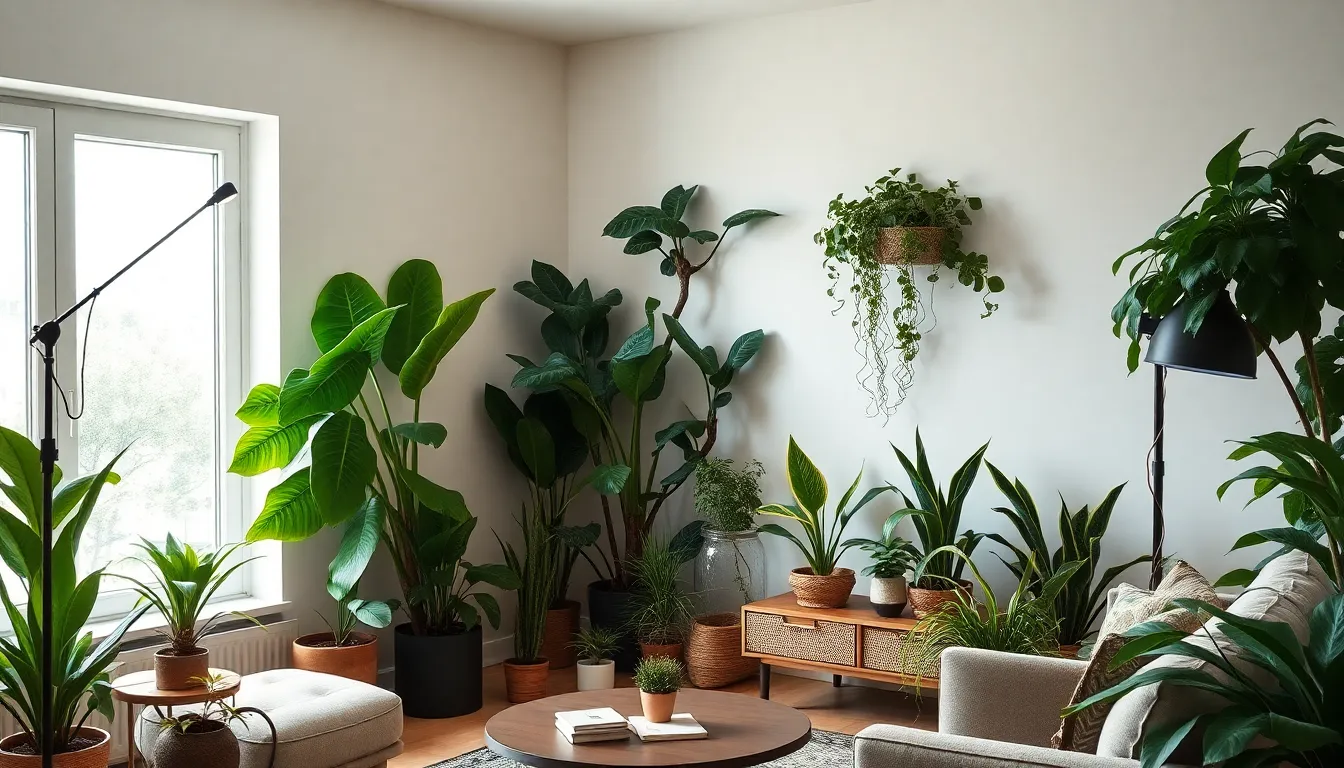
Successful plant care requires matching each variety with its exact lighting needs. We’ve found that strategic lighting placement transforms any living room into a thriving plant paradise.
Add Grow Lights for Low-Light Areas
Grow lights solve the challenge of maintaining healthy plants in dimly lit corners and rooms. We recommend installing grow light bulbs in existing floor lamps and table lamps to seamlessly blend functionality with your décor. LED strips provide another excellent option for shelving units where multiple plants need supplemental lighting.
Timer systems add convenience to grow light setups by automatically providing consistent light schedules. Aesthetic grow lights now come in stylish designs that complement modern living rooms while delivering the full spectrum plants require. These answers enable us to place plants anywhere in our living space regardless of natural light availability.
Use Accent Lighting to Highlight Plant Displays
Accent lighting showcases plants as stunning decorative features while creating inviting ambiance. Spotlights positioned above or beside plant arrangements draw attention to layered displays where taller plants anchor the back and shorter varieties fill the front. LED strip lights installed behind plant shelves create dramatic backlighting effects that emphasize leaf textures and shapes.
Track lighting offers flexibility for illuminating multiple plant groupings throughout the room. We suggest grouping plants with similar light requirements together to create cohesive displays that accent lighting can enhance effectively. These lighting techniques transform ordinary plant collections into captivating focal points.
Position Plants Near Natural Light Sources
Windows provide the most cost effective lighting solution for most houseplants. We position fiddle leaf figs and rubber plants near areas with bright indirect light where they can flourish naturally. Snake plants, ZZ plants, and pothos excel in spots with lower natural light levels, making them perfect for corners with limited window access.
Sheer curtains help diffuse harsh direct sunlight while maintaining the bright conditions most plants prefer. Hanging planters and wall mounted shelves maximize available window light without cluttering floor space or blocking pathways. Strategic placement near natural light sources reduces energy costs while supporting optimal plant health throughout your living room.
Maintain Your Living Room Plant Paradise
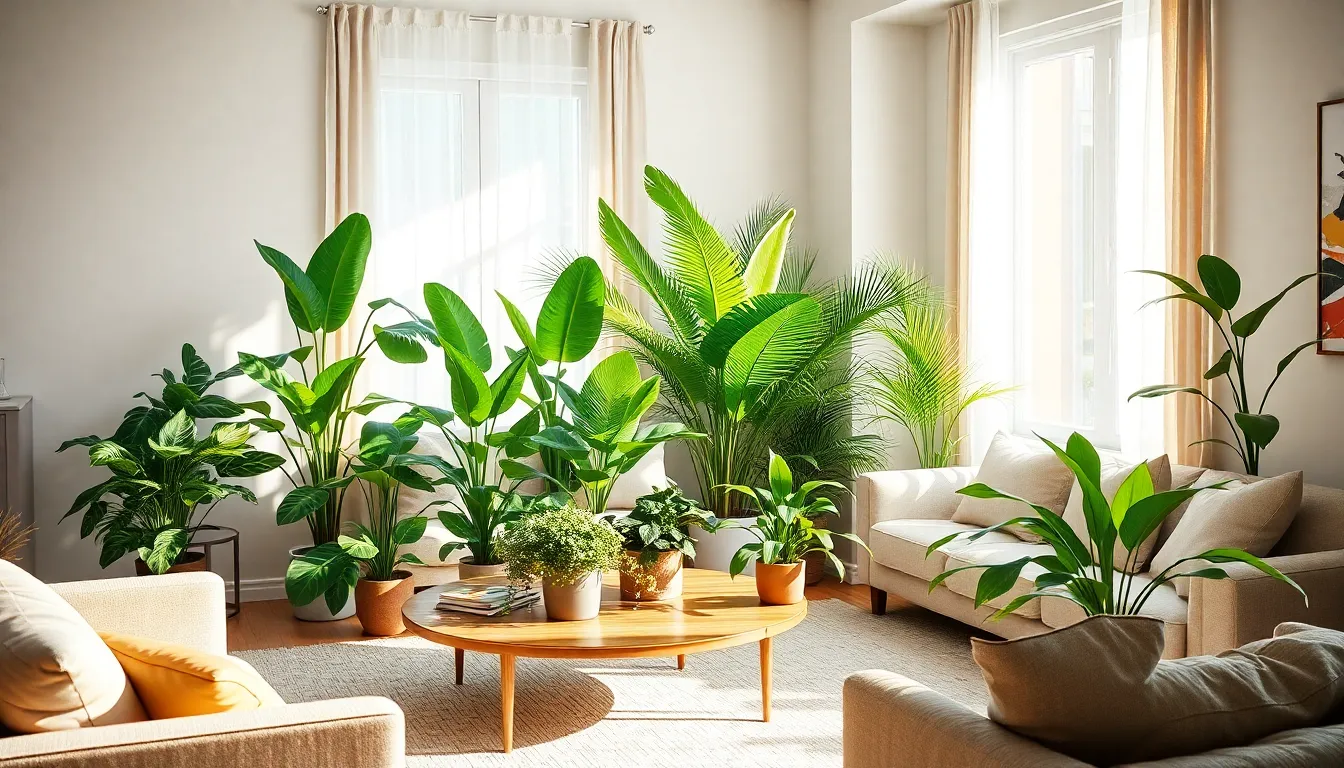
Creating a thriving indoor garden requires consistent care and attention to keep your plants healthy and beautiful. We’ll guide you through essential maintenance practices that ensure your living room paradise flourishes year-round.
Establish a Regular Watering and Care Routine
Watering schedules vary significantly based on plant species and their exact needs. Umbrella Plants require minimal watering and thrive with infrequent deep watering sessions, while Areca Palms need consistent moisture approximately every ten days. We recommend checking soil moisture levels before watering to prevent overwatering, which remains the leading cause of houseplant failure.
Proper drainage prevents root rot and maintains healthy plant growth. Place saucers under pots to catch excess water and empty them within 30 minutes of watering. Monitor lighting conditions regularly and adjust plant placement when seasonal changes affect natural light availability.
Create a weekly care schedule that includes dusting leaves, rotating pots for even growth, and checking for basic maintenance needs. String of Pearls and other drought-tolerant plants forgive occasional underwatering, making them perfect for busy schedules or beginners learning proper care techniques.
Monitor Plant Health and Address Issues Quickly
Regular plant inspections help identify problems before they become serious threats to your living room paradise. Check leaves weekly for discoloration, yellowing, brown spots, or unusual drooping that might indicate watering issues or pest problems. Early identification of aphids, spider mites, or fungal diseases allows for prompt treatment using gentle, plant-safe answers.
Yellowing leaves often signal overwatering, while brown, crispy edges typically indicate underwatering or low humidity levels. Pest infestations appear as tiny insects, webbing, or sticky residue on leaves and stems. We suggest isolating affected plants immediately to prevent spread to healthy specimens.
Watch for environmental stress signs like sudden leaf drop, which commonly affects Areca Palms when moved to new locations. Address lighting issues by relocating plants or supplementing with grow lights when natural light proves insufficient for optimal growth.
Seasonal Plant Rotation and Replacement Tips
Seasonal rotation maximizes plant health by matching species to optimal growing conditions throughout the year. Move light-loving plants closer to windows during darker winter months and relocate them to shadier spots during intense summer heat. This practice ensures consistent growth and prevents seasonal stress that weakens plant immunity.
Replace tired or unhealthy plants with fresh specimens that suit current environmental conditions in your living room. Consider seasonal varieties that thrive in exact humidity and temperature ranges, swapping tropical plants for hardier species during heating season when indoor air becomes drier.
Rotate plant positions monthly to ensure even light exposure and prevent leaning toward light sources. This simple practice maintains symmetrical growth patterns and keeps your living room display looking balanced and professionally arranged throughout changing seasons.
Conclusion
We’ve shown you that transforming your living room with plants doesn’t require a green thumb or major budget. With the right plant selection lighting setup and strategic placement you can create a stunning indoor garden that enhances your space’s beauty and air quality.
Remember that success lies in matching plants to your lifestyle and room conditions. Whether you choose dramatic floor plants cozy reading nooks or elegant hanging displays the key is creating a maintenance routine that works for you.
Start small with one or two plants and gradually build your collection. Your living room will become a thriving green sanctuary that brings nature indoors and creates the peaceful atmosphere you’ve always wanted.
Frequently Asked Questions
What are the benefits of adding plants to my living room?
Plants enhance your living room’s aesthetic appeal while improving air quality and creating a calming atmosphere. They provide a cost-effective way to transform your space without major renovations, bringing natural beauty indoors and supporting biophilic design principles that connect you with nature.
How do I choose the right plants for my living room lighting conditions?
Match plants to your room’s light levels: sun-loving plants for bright, south-facing windows; versatile options like pothos for medium light areas; and shade-tolerant varieties like snake plants for low-light corners. You can also use grow lights to expand placement options in darker spaces.
What are some low-maintenance plants perfect for busy lifestyles?
Drought-tolerant succulents, snake plants, ZZ plants, and pothos are excellent choices for busy people. These resilient varieties require minimal watering and care while still providing beautiful greenery. They’re forgiving of occasional neglect and adapt well to various indoor conditions.
How can I create a plant corner or reading nook?
Transform empty corners into green sanctuaries by layering plants of varying heights. Use large floor plants as anchors, add medium-sized varieties for depth, and include trailing plants for visual interest. Combine comfortable seating with easy-care plants like pothos or snake plants for a tranquil reading space.
What’s the best way to display hanging plants in my living room?
Install ceiling hooks or wall-mounted brackets to support hanging planters safely. Choose trailing varieties like English ivy, heartleaf philodendrons, or spider plants for dramatic cascades. Use macrame hangers or decorative containers that complement your decor style while ensuring proper drainage.
How do I select the right containers for my plants?
Choose containers that complement your existing decor theme—minimalist ceramics, rustic baskets, bohemian macrame, or industrial metal planters. Mix different textures and materials for visual interest, and ensure proper drainage. The container should be proportionate to both the plant and your space.
Can I integrate plants into my existing furniture?
Absolutely! Transform shelves, side tables, and coffee tables into living displays with small potted plants. Create succulent gardens on coffee tables using low-profile containers, add plant ledges to window sills, and style console tables with varying plant heights and textures for curated looks.
Do I need special lighting for indoor plants?
While many plants thrive in natural light, grow lights can help plants in low-light areas. Use grow light bulbs in existing lamps or LED strips under shelves. Position plants near windows with sheer curtains to diffuse harsh sunlight, and maximize natural light with hanging planters.
How often should I water my indoor plants?
Watering frequency depends on the plant type, pot size, and environmental conditions. Most houseplants prefer soil that’s slightly dry between waterings. Check soil moisture by inserting your finger 1-2 inches deep—water when dry. Establish a routine but adjust based on seasonal changes and plant needs.
How do I maintain my indoor plant collection year-round?
Establish a regular care routine including watering, pruning, and monitoring for pests or diseases. Rotate plants seasonally to match optimal growing conditions, moving them closer to or farther from light sources as needed. Clean leaves regularly and repot when plants outgrow their containers.

